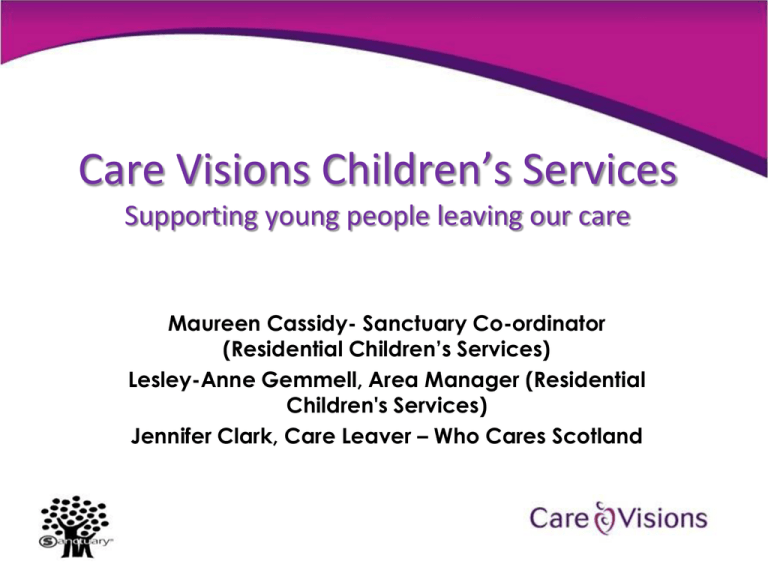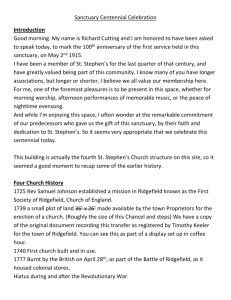
Care Visions Children’s Services
Supporting young people leaving our care
Maureen Cassidy- Sanctuary Co-ordinator
(Residential Children’s Services)
Lesley-Anne Gemmell, Area Manager (Residential
Children's Services)
Jennifer Clark, Care Leaver – Who Cares Scotland
Care Visions Children’s Services
• Scotland’s largest independent provider of residential care for
•
•
•
•
children. Our first house opened in 1998
One of the country’s leading independent providers of
fostering
We specialise in working with some of the most vulnerable
children and young people
We help children and young people understand their
experiences and help them to ‘recover’.
Committed to professional development and training of staff
through the Sanctuary model – caring for children and young
people from a trauma perspective.
What do we know?
The outcomes for young people leaving
What do we know?
care are poor
Why ?
Homelessness/Roofless
Prison
Unemployment
Depression
Domestic violence
Addiction
Abuse
Poverty and destitution
Loneliness
National Policy
• There has been recognition in national policy of the need to
improve support for care leavers in Scotland. More Choices,
More Chances (Scottish Executive, 2006), Looked After
Children and Young People: We Can and Must Do Better
(Scottish Executive, 2007) and These are Our Bairns: a Guide
for Community Planning Partnerships on being a good
corporate parent (Scottish Government, 2008) are some of the
guidance and policy outlines which have stressed the
importance of the support we need to give young people in
our care and our care leavers.
At Care Visions we believe that every young
person has the capacity to recover from
trauma and adversity and, against the odds,
can look forward to a bright
and fulfilling future.
To help
achieve this we use …
The Sanctuary Model
Why Sanctuary?
• It provides a framework for recovery.
• It enhances the quality of care.
• It helps children, young people, and carers make
sense of how present behaviours are informed by past
experience.
• It teaches children and young people to replace
actions with words; self harm with self care strategies.
Four Pillars of Sanctuary
• Trauma Theory – a foundation for creating a trauma informed
environment.
• S.E.L.F. – a model which organises the way in which we think
about individuals, organisations and recovery.
• The Seven Commitments – our value base which guides
individual beliefs, practices and policies.
• Sanctuary Tools – a range of resources and activities aimed at
helping individuals make sense of trauma.
The ACE’s Study
• The largest study of its kind ever done to examine the health and
•
social effects of adverse childhood experiences over the lifespan
(Felitti & Anda)
Adverse Childhood Experiences- Trauma and Loss
• The more ACE’s a person is exposed to the greater the risk of
chronic disease, premature mortality, substance abuse, chronic
depression, poor mental health and victims of violent relationships
• Virtually every study shows that ACE’s are strong predictors of
homelessness
(Burt, 2001)
Trauma
What is trauma?
“ Trauma is an overwhelming
event that causes intense
feelings of fear, helplessness
and horror.”
Dr S.L. Bloom
“Traumatisation occurs when both
internal and external resources
are inadequate to cope with
threat”
Bessel Van der Kolk 1989
What we know about trauma?
Trauma interferes with the integration of left and right
hemispheres of the brain. This occurs to such an
extent that young people cannot access rational
thought in the face of overwhelming emotion and are
prone to react with extreme helplessness, confusion,
withdrawal or rage.
When we are terrified, language fails us.
Fear can look like this!
Fear can look like this!
But feel more like this!
How do such children and
young people present?
• Foreshortened and diminished view of future
• The world has become a bad place
• Inability to trust. No expectation of recourse to justice
• Attributing hostile intentions to neutral stimuli (constantly under
threat)
• Problems with sex and sexuality
• Maladaptive coping mechanisms- harming self through
substance abuse, self harm and risk taking behaviours
• Re-victimised in adult life or re-create violent relationships
• Harming others, re-enacting but putting others in victim role
A baby exposed to constant harm and threat
will develop into a child/adult in a constant
state of alarm and readiness to react to any
perceived threat.
The S.E.L.F Framework
Safety-
No-one can recover or works well without having a sense of safety.
Safety means physical safety, emotional safety, social safety and
moral safety. Safety is where we always start a end. If you are not
safe, you cannot recover effectively.
Emotions-
Managing emotions is the step that helps us to know what we are
feeling and to handle our feelings in a way that doesn’t hurt
ourselves or others.
Loss-
Loss is the step that helps us acknowledge and grieve the painful
things that have happened to us, in a safe way. Then we can let go,
and move to a healthy future.
Future-
Future is the step where we look at our choices in creating a better
personal future.
Seven Commitments
• Non violence -
3 components of communication consist of :words 7%; tone
of voice; 38%, body language 55%.
• Emotional intelligence - managing our feelings so that we don’t hurt
ourselves or others.
• Social learning -
respecting and sharing the ideas of our teams.
• Democracy
shared decision making.
-
• Open communication - saying what we mean and not being mean when we
say it.
• Social responsibility -
together we accomplish more. Everyone makes a
contribution to the organisational culture.
• Growth and change -
creating hope for our clients and ourselves.
The Sanctuary Toolkit
• Community Meeting
• Red Flag Meetings
• Safety Plans
• Self Care Plans
• Team Meetings
• Care Reviews
• Self Education
The Sanctuary Model
• Emphasis on Safety
• A platform for understanding experiences of trauma and adversity
• Development of positive relationships and forming appropriate
attachments.
• Helps build self esteem
• Enhanced cognitive skills- i.e. problem solving and decision making.
• Improved emotional management
• Restores hope for the future.
Sanctuary is not a sickness model but
a social/recovery model
And finally ………
Just when
the caterpillar
thought its world
was over ….
It became
a butterfly
-anonymous












